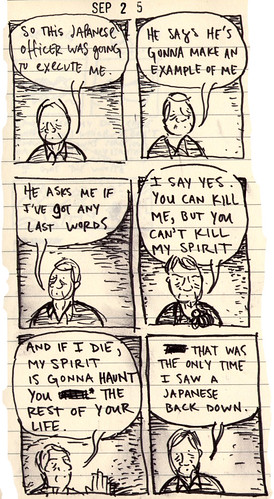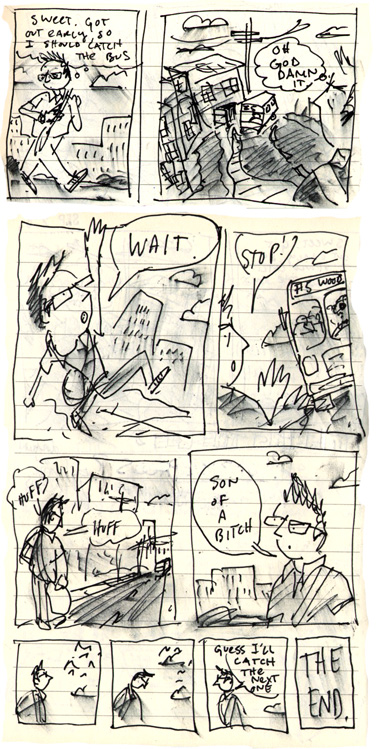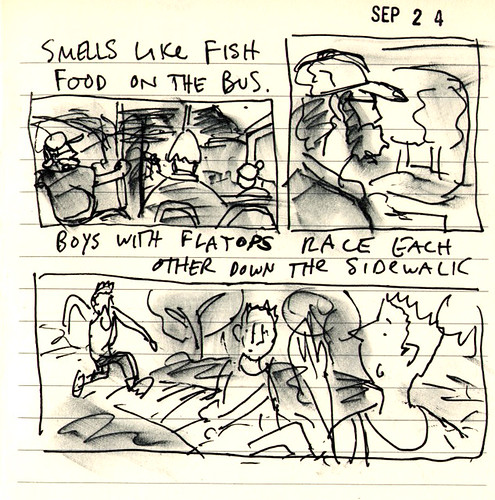I like to draw while watching TV: I drew this while watching Ken Burns’ new documentary, which is quite good. The guy who told this story is a badass.
VONNEGUT: THREE ACTS OF PUNCTUATION

For my buddy Brandon, who starts teaching his first creative writing class today, an excerpt of an old NYTimes article from 1971:
The class began in a surprising way. Vonnegut remarked that last time they had been talking about form, and he walked to the blackboard and drew there a question mark, an exclamation point and a period. He said these bits of punctuation were the outline of a three-act story.
A DAY IN THE LIFE OF PUBLIC TRANSPORTATION
MORE ANDERS NILSEN
On inspiration:
[M]yths, fairy-tales and religious stories like the Bible…They are endlessly interpretable and adaptable. A bottomless source. They’re the template for pretty much all storytelling in the Western world. Whether by design or by stumbling onto them I think there is much to be gained from brushing up against them, borrowing, stealing, rewriting and quoting from them, whether subtly…or overtly…”
On not-knowing:
…when making comics is working, it really doesn’t feel like you are the one telling the story, it feels like the story already exists and you are just doing your best to get it down on paper. It’s like a very carefully attentive manufacturing process. So for the story to change would be like for someone who assembles calculators to start changing the calculators. They probably wouldn’t work.”
On art and religion:
All art comes from religion. From trying to understand and contend with the world.”
On the artist disguising himself in his work:
I’m happy to be back to my usual practice of heavily disguising my life in the stories I tell. Generally speaking, it’s still me in my other work, it’s just that I’m disguised as a bunch of little birds.”
DAVID HEATLEY ON COMICS AND GRAPHIC DESIGN
I keep thinking about Seth’s equation of poetry + graphic design = comics, and it keeps making more and more sense to me. In his recent Inkstuds interview, David Heatley talked a little bit about how getting into graphic design influenced his comics work:
Robin McConnell: You’re also a graphic designer, but you utilize your cartooning within your graphic design work.
David Heatley: I guess I’d say I’m mostly an illustrator…I’ve done graphic design work as my job for 7 or 8 years, but it’s always been sort of a day job. What I’ve learned their I’ve actually put more into my comics, rather than the other way around. I’ve learned what good clean design looks like, about the hierarchy of information, using symbols, typography…all those kinds of things I’ve put over into my comics toolbox….While in art school I worked in my first design shop, and probably learned as much there as I did in school. At the time I hated computers, I hated ads, I thought everything was corporate BS and I didn’t want anything to do with it., My boss really spun my head around. He showed me old logos from the fifties, and I would copy those in my sketchbook. He showed me the constructivist posters, and he opened this whole world of design up to me that I never really knew about. Most of the time I find myself in bookstores gravitating to the design section and graphic arts more than fine arts, so [working in that design shop] was pretty seminal.
- ← Newer posts
- 1
- …
- 526
- 527
- 528
- 529
- 530
- …
- 635
- Older posts→


